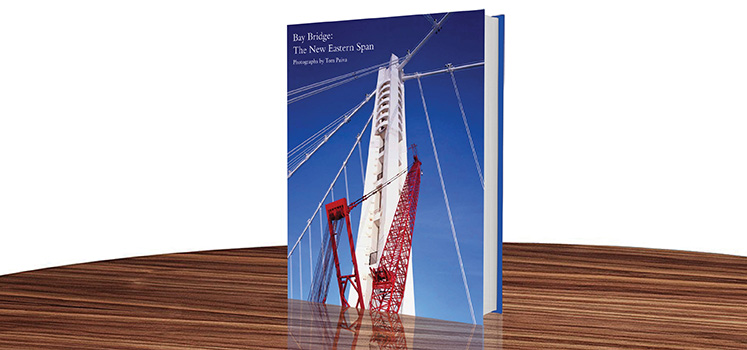On a recent ride from San Francisco to Oakland, we spotted a number of fellow travelers carrying these two fine illustrated tomes.

By Paul Duclos
On a recent ride from San Francisco to Oakland, we spotted a number of fellow travelers carrying these two fine illustrated tomes.
San Francisco: A Map of Perceptions
Here, the architect Andrea Ponsi unravels the multifaceted beauty of San Francisco, introducing even those who have lived here for years to nuances often left unseen. Ponsi, a native of Florence who lived in San Francisco for many years, lyrically describes everyday life in the city, from a café in North Beach where he sits next to Lawrence Ferlinghetti, to the de Young Museum (“a solid mass, a rough but elegant body, faceted but compact”) and the Academy of Sciences (“an ethereal, transparent building, lace made of glass and slender columns”), to Alcatraz (“an abandoned ship, a Flying Dutchman set adrift that bears the signs of a life of torment”), and even to the buffalo who reside in Golden Gate Park. A series of epigrams characterize this enchanting work.
Here is Ponsi’s concluding observation on foghorns: “A repeated, slow cry, almost the lament of a desperate animal, a dark, dene, deep, dragged-out sound. Then silence. The cry once again. It is an immense ship crossing through the fog on the bay. A giant that goes its way unseen, after the ocean, heading for port.”
The author also praises two of our favorite North Beach bookstores: City Lights and William Stout. There is no bitterness or rancor in the book, but Ponsi does strike a sad note when discussing the proliferation of high rises South of Market, and the explosive commercial growth transforming all of the city’s neighborhoods.
As with his book on Florence, Ponsi here reveals a deeply personal look at what it’s like to live in and love a city. Having the unique perspective of having been both an insider and an outsider to San Francisco, he speaks to us in the way we dream an architect would, capturing the city’s diverse yet emblematic structures through delicate watercolor and line drawings, while also offering poetic descriptions of the underlying smells, sounds, and light of its many neighborhoods.
A perfect balance of text and illustrations, San Francisco: A Map of Perceptions offers not only a guide for those visiting or returning to the city but also a compelling invitation for residents to revisit the utterly unique place in which they live. For more information, see www.upress.virginia.edu.
Bay Bridge: The New East Span
Here, photographer Tom Paiva has richly documented the latest chapter in the history of spanning California’s East Bay.
In the late 1920s, economic and social changes in the Bay Area, including the increasing popularity of automobiles, prompted the California legislature to establish the California Toll Bridge Authority and charged it with connecting San Francisco and Alameda County.
The groundbreaking ceremony for the longest bridge in the world at that time took place on July 9, 1933, and presaged a three-year project at a cost of $77 million (over $1.3 billion in 2016 dollars). When it opened on November 12, 1936, the Bay Bridge caused “the greatest traffic jam in the history of San Francisco.” During its first year of operation, the Bay Bridge was crossed by nine million vehicles.
The 50th anniversary of the completion of the Bay Bridge, which actually includes both a suspension bridge and a truss bridge, took place in 1986. Three years later, the Loma Prieta earthquake damaged the East Span, even though the epicenter of the 7.1-magnitude earthquake lay nearly 90 miles south.
After 53 years and many millions of vehicles safely transported, the bridge was showing its age, prompting plans to create a more enduring structure.
In 2002, the 11-year construction project on the new Bay Bridge began, involving a complete retrofit of the suspension bridge and the replacement of the truss bridge with the world’s longest self-anchored suspension span.
Photographer Tom Paiva, on an aerial assignment in the Bay Area, happened upon the initial phase of the project and knew that he had to become part of it. Assigning himself the task of recording the creation and the construction of this monumental structure from his vantage point, Paiva believed that his unique vision would offer a valuable, yet complementary, view of the $6 billion enterprise. His quest was to contribute a lasting document that would honor the visionaries—past and present—who could imagine and create these imposing, yet beautiful, man-made spans.
With Bay Bridge: The New East Span, Tom Paiva has produced a masterful body of work, documenting one of the most daunting, and finally triumphant, engineering feats of our generation. This beautifully produced, oversized monograph pays fitting homage to its subject, and all of those who were involved in its creation. For more information, see www.nazraeli.com.
Follow Paul Duclos’ Cultural Currents online with his blog at: paulduclosonsanfranciscoculture.blogspot.com

